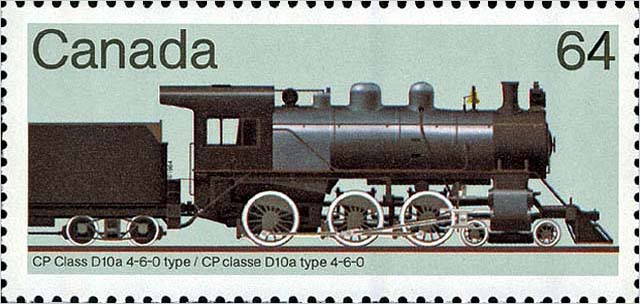
This stamp is from a souvenir sheet of four locomotives named "Canadian Locomotives (1860-1905)" containing 0-6-0 Scotia, 4-4-0 Countess of Dufferin, 2-6-0 Grand Trunk class E3, and 4-6-0 Canadian Pacific class D10a issued on 25 Oct 1984 for the National Philatelic Exhibition Montreal 25-28 Oct 1984. |
The moon shone brightly that night, illuminating both the narrow track ahead and the huge expanse of water to the right. A huge plume of steam rose from the D10b locomotive, CP 694, as she chugged along in the early morning hours on 10 Jun 1910.
From his vantage point, Mr. McMillian the front brakeman, could easily make out all the constellations in the northern sky. Ursa Major, Ursa Minor, and Orion's Belt sparkled brightly, free from the interference of town lights. While the June air still had the cool sting of an early spring night in northern Ontario, he was comfortable in his warm jacket.
The train was making excellent progress, proceeding at an approximate speed of 35 miles per hour. Having boarded the train a few hours earlier in the town of Schreiber, McMillian now chuckled to himself as he reflected on how he had nearly missed the train. Needing the money, he was glad that he had not. Little did he, or anyone else on board, suspect what was about to befall them as they approached the Mink tunnel near Coldwell.
Out of the darkness, McMillian suddenly made out the outlines of a large boulder resting on the tracks, it had ostensibly rolled down the adjacent cliff. Given the train's speed, McMillian realized that the train could not be stopped in time, panicked he jumped from the train. The impact of his body against the ancient Precambrian bedrock was fatal. Sadly, he would not be the only victim that night.
With a crunching sound of metal hitting rock, the big D10b locomotive struck the boulder. The locomotive, tender, and the first two boxcars, with nowhere to go, lurched over the embankment and down the 60 foot cliff into Lake Superior. The train took with it to the depths Frank Wheatley the engineer, and E. Clarke the fireman. The big lake, called "Gichigami" by local tribes, had claimed a few more souls.
The damage was extensive. In addition to the loss of three people, a locomotive, a tender, and two boxcars, approximately 40 meters of track had been destroyed, which shut down a vital east to west rail line for the Canadian Pacific Railway (CPR). In addition, two telegraph poles had been knocked down, crippling telegraph communication for CPR to the east. For this reason, local CPR officials were the last ones to know what had happened.
Unfortunately, the tragic story of CP 694 would soon be eclipsed by the losses of the luxury yacht "Gunilda" in Rossport the following year, and the sinking of the Titanic in 1912. With the outbreak of World War I in 1914, the story of the unfortunate D10b locomotive was remembered only by local residents along the north shore of Lake Superior. Interest in the ruined locomotive would be on hiatus for roughly 100 years.
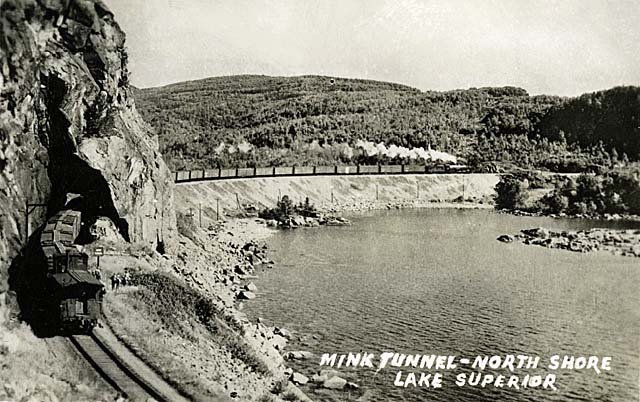
Western Development Museum WDM-1994-S-438.
The ringing of the telephone interrupted an otherwise dull day in February 2014. The call display revealed an 807 area code, belonging to Schreiber, Ontario. Intrigued, I picked up the phone. A deep, powerful voice resonated through the receiver.
"Hello, Mr. Irvine," stated the caller. "My name is Bob Krause, and I am the Councilor of the town of Schreiber. I understand that you are planning to dive with Paul Turpin this summer and I would like to talk with you about looking for a locomotive that sank in Lake Superior in 1910."
Bob Krause was right, we were planning to dive the wrecks of the "Gunilda" and "Judge Hart" during the 2014 season. What Bob Krause did not know was that our charter operator and good friend Paul Turpin had also suggested looking for a lost steam locomotive in Lake Superior in the same general area as the "Judge Hart" during chats in November 2013. Now, Bob Krause filled in details of what had previously been only an exciting idea.
We chatted for roughly twenty minutes. During this time Bob shared a few more details of the train incident with me, while I outlined what would be involved to undertake technical dives in remote sections of Lake Superior. A mutual enthusiasm began to build over the phone, and preliminary plans to look for CP 694 began to take shape. I told Bob that our dive team would coordinate travel and exploration details through Paul Turpin and Discovery Charters. In response to Bob's question about potential funding by the town of Schreiber, I replied that any funds donated by Schreiber would be allocated to the cost of towing Paul Turpin's boat from Rossport to Marathon, ninety minutes away, and then transporting us to the remote location where the train derailed. Schreiber was a small railroad community and financial resources were scarce.
As the trip grew closer, one detail about the wreck site remained unclear, the depth. No one could give us an idea of how deep the train might be.
"It could be in 40 feet of water or it could be in several hundred feet of water" Paul Turpin explained. "People climbing the nearby cliffs have apparently seen wreckage below the water on a sunny day." Unfortunately, that did not help in planning the appropriate dive gas for the site.
Lake Superior has some of the clearest water of all the Great Lakes, but it tends to be dark. Additionally, the railroad track itself was sixty feet above the surface of the water, and the adjacent cliff was several hundred feet higher yet. Assuming that the topography below the waterline was similar to that above the waterline, the train could be deep.
"Ah, Superior," I thought. "Nothing can ever be shallow!" We would already have the right gas for 270 feet (80 meters), our "Gunilda" gas, and for 200 feet (60 meters), our "Judge Hart" gas. We would use these trimix gases as a starting point, hoping that the 270 foot gas would get the job done.
With a week's worth of trimix and decompression gas blended, we started the journey northward for some of the most amazing diving in any of the Great Lakes. While we were excited about returning to dive the "Gunilda" and the "Judge Hart" again, the anticipation of diving something new created a buzz amongst the group.
The "D10" class of locomotives formed the backbone of the CPR fleet during the steam era that extended from the late 1880s well into the 1960s. CPR owned over 3,200 locomotives, with 502 of them in the D10a to D10k class. The D10 class locomotive was a "Ten-Wheeler" type with a 4-6-0 wheel arrangement. There were four leading wheels on two axles in the leading truck, six powered and coupled driving wheels on three axles in the center portion of the locomotive, and no trailing wheels. The leading wheels provided good stability while travelling at speed and supported the larger boiler introduced in the early 1900s. This combined with the six powered wheels made the D10 locomotive a sturdy, reliable, and versatile engine suitable for both freight and passenger applications. Nearly all of the 502 D10 locomotives used by the CPR were built in Canada at either the CPR Angus shops in Montreal, the Montreal Locomotive Works (MLW), or the Canadian Locomotive Company (CLC), in Kingston, Ontario. Approximately 50 locomotives were manufactured in the United States, half built by Richmond, and half by Schenectady.
The D10 locomotive boasted some impressive specifications for the technology of the day. These machines were typically over 65 feet (20 meters) long, 15 feet (4.6 meters) high, and weighed in at 364,000 pounds (165,108 kilograms). The D10 locomotive had a tractive force of 33,300 pounds. Unlike later diesel-electric locomotives that had a finite horsepower at any speed, the steam locomotive could develop more horsepower as it increased speed. If the D10 had enough torque to get the load moving, it could increase its horsepower as it gained speed.
A number of the D10 class locomotives remained in active service until the CPR discontinued using steam locomotives in 1960. Of the 48 CPR locomotives preserved in museums, 10 are D10 models. CP 926 is still on display at the National Museum of Science and Technology in Ottawa, Ontario. Another engine, CP 1098, is out of service at Port Clinton, Pennsylvania, since its owner RailTours Incorporated of Pennsylvania effectively went out of business on 1 Jan 2005.
We arrived at the small town of Marathon at noon on a Saturday morning and met Paul Turpin at a local coffee shop. We were eager to do a reconnaissance dive of the site and gain a further understanding of the underwater topography where the train derailed. With Paul was Doug Stefurak, a steam locomotive historian, and Daniella Carlino from Parks Canada, who had been charged with documenting the events for the local Schreiber paper. Doug had studied the story of CP 694 for many years and showed us a huge scrapbook replete with newspaper clippings and photographs of the locomotive. He had even commissioned the manufacture of a brass model replica of the train and tender. Our excitement grew as Doug spewed out detail after detail about the locomotive and the incident.
We had hoped to keep our exploration quiet until we had something to report. There was a real possibility that we may not find anything at all. The train may have exploded when the hot boiler hit the cold water, it may be deeper than we were prepared to dive to, or it may have even been secretly salvaged and put back into service. But this was Northern Ontario and news of this sort could not be contained. A week before our arrival, the headline, "Divers on a Hunt" graced the front page of the Thunder Bay newspaper.
"So much for a stealth operation," I thought as I ate my sandwich. "I sure hope we find something." With lunch concluded, a plan discussed, and the boat launched, we were ready to head to the dive site.
The 35 minute ride to the site on Paul's rigid-hulled inflatable took us amongst some amazing scenery. The archipelago islands that dotted the northeastern part of Lake Superior were a rich shade of green. Our boat wake shimmered in the mid-August sunshine. The previous winter had left its mark on the lake, however. The ice had not completely disappeared from Lake Superior until June, and the water was much colder than it had been two years earlier. During our 2012 visit to this area, it was not uncommon to get temperatures of 55 degrees Fahrenheit (13 degrees Celsius) at 20 feet (6 meters). This year, we would not see temperatures higher than 42 degrees Fahrenheit (5 degrees Celsius) during our final decompression stops.
The objective for our first dive was relatively simple. Using Diver Propulsion Vehicles (DPVs), we would explore the bottom topography at the wreck site to better understand the depths in the area. In case we ran across something worthy of a photograph, I mounted a camera on my DPV. We had gas that would allow us to explore to depths of 200 feet (60 meters). Almost immediately into the dive, we encountered problems. The visibility was poorer than we had hoped for, making it a challenge for the team to stay together. A sticky wing inflator added to my woes (used for adjusting a diver's buoyancy). Determined, however, we pushed on.
As we scootered west from the Mink Tunnel at a depth of 160 feet (49 meters), we ran across some wooden boards and other debris, but not much else. It was when we ascended to shallower water to complete our decompression that Greg Hilliard signaled that he had found something. In approximately 40 feet (12 meters) of water we discovered a set of wheels. Using Greg's scooter for scale, we estimated the diameter of the wheels to be approximately 26 inches (66 centimeters). In addition to the wheels, there was a heavy duty leaf spring on each side of the wheel assembly and a brass plate that had "CPR" stamped into it.
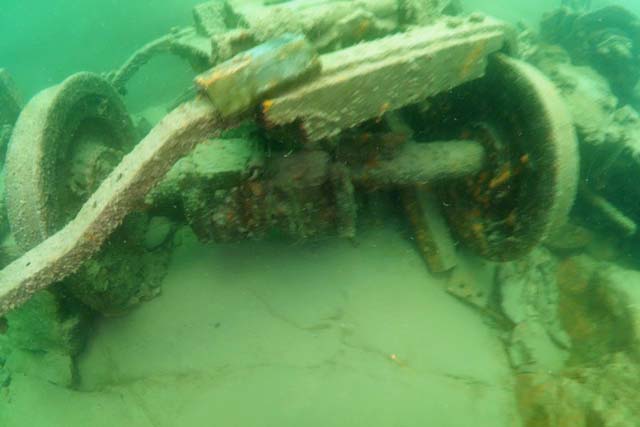
We took a few photographs and finished our decompression, excited to have found something. With the diving finished for the day and the boat back on the trailer, we headed back to Rossport for the evening to enjoy a meal with Paul Turpin and his wife Beverly and to review the photos.
Bob Krause was already at Paul's house when we arrived, eager to hear about the dive's outcome. I am not a small person but my hand disappeared into Bob's when we met. His rugged features reflected many years of working on the railroad, and even though he had retired from the railroad a number of years ago, he still had a powerful stature.
Bob listened intently as we described the day's diving and studied each photo with keen interest.
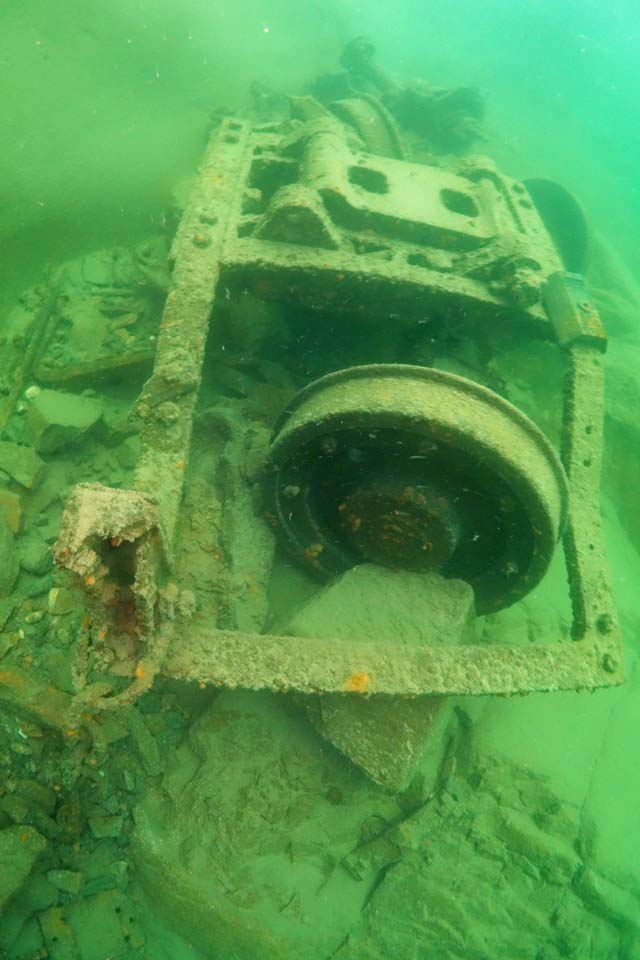
"I need to get these photos to some of my train buddies," he said. "Hopefully they will know where this wheel assembly is from."
Our first thought was that the wheels might be from the tender car as they seemed a bit small to be the pilot wheels under the locomotive's boiler, but we could not be sure. With the photos copied onto a flash drive, and the northern sun finally setting for the day, it was time to retire for the night. While the plan for the next few days was to dive the "Gunilda" and the "Judge Hart", a number of us were already looking ahead to the next dive at the train site.
For the next train site dive, we adopted a different strategy. Again on DPVs, we would begin at the spot where we found the wheel debris and run a course perpendicular from shore down the wall. Since we had gas that would allow us to go to approximately 220 feet (67 meters), we set that as our maximum depth for the dive. We also decided to limit our bottom time to 30 minutes given that the water was cold, even during decompression. With final buddy checks completed and a "big okay", we started down the wall.
As we had surmised, the underwater topography was analogous to that above the water. At a depth of 50 feet (15 meters), we encountered a sheer wall that descended vertically to 200 feet (61 meters). Ambient light disappeared at 80 feet (24 meters) and from that point on we relied entirely on our lights. With the scooters on slow speed, we carefully studied the bottom in search of more debris. Minute after minute, meter after meter, nothing came into view. We strained our eyes in search of what might be just beyond the reach of our beams. Then suddenly, debris!
While the structure was badly crumpled, we could make out semi-circular shapes and what appeared to be some sort of door on the bottom. Could this be part of the roof from the doomed locomotive? We quickly made an inspection of the debris, but could find nothing definitive. With our bottom time quickly expiring, we snapped a few photos and started to serpentine our way back up the wall in search of other objects. At a depth of approximately 150 feet (46 meters), we ran across several large tubes with a diameter of approximately 15 to 20 inches (38 to 50 centimeters). Given their size, we wondered about their origin and function. Shallower still, we came across several old mechanical hand carts that would have been used to carry work crews along the track. After many years underwater the CP embossed letters could still be seen on the carts.
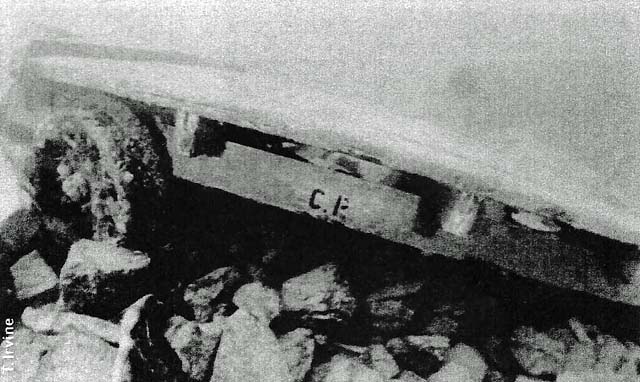
Back on the boat, we were eager to share our latest adventures and photos with Paul, who was able to shed some light on why the CPR hand carts were on the bottom.
"Funny thing about that, as soon as the gasoline-powered hand carts were introduced, the older manual hand carts suddenly started flying off the tracks and disappeared into the water. It took CPR nearly five years to figure out why the carts were suddenly unsafe and derailing." Back in Marathon, the boat and gear secured for the evening, the objectives for the final dive of the trip were discussed.
Based on depth readings Paul obtained that day, the depth on the wall was much greater than we had anticipated. Only 75 meters from shore, the lake depth registered nearly 500 feet (152 meters), far deeper than we were prepared to go on this expedition. If it remained intact when it hit the water, a heavy locomotive might have continued rolling all the way to the very bottom. Despite the dampening news, we remained optimistic that we might find more evidence on our final dive. With batteries charging and dive gases readied, we headed off to bed, our minds still abuzz with thoughts of the locomotive.
Although the day was sunny, the weather had cooled and a thick fog blanketed Mother Superior. "This could make locating the right spot along the shore tricky," I thought as we pushed off from the dock. But Captain Paul would not be deterred, and within an hour of departure, we were back at our familiar rock face. This would be our final chance to find something this dive season. With gear verified and a final buddy check, we headed down the now familiar wall and into the black.
Like the previous day, the first few minutes of the dive revealed nothing more than inky blackness and huge rocks strewn along the bottom. We pushed deeper with the scooters and continued in a westerly direction. I stopped briefly to adjust a setting on the camera and check our depth. We were at 285 feet (87 meters). Suddenly, a light flickered back and forth. Greg had found something. Jutting up from between several rocks was one of the boxcars! It lay on its side, badly damaged but still very much intact. I swung the camera strobes into position and quickly started snapping photos.
It appeared as if the wheels had been ripped off the boxcar, either when it left the track, or when it plunged down the underwater cliff. At one end of the car appeared what seemed to be one of the automatic knuckle couplers. We examined the boxcar for several minutes, looking for markings to help identify its origin or perhaps connect it with the lost locomotive. We were unsuccessful. The inside of the boxcar was empty, perhaps the contents had smashed through one of the side walls during the sinking and were lost. We spent a few more minutes with the scooters conducting sweeps around the boxcar, but found nothing else. With our decompression obligation increasing rapidly, we reluctantly began our return to the surface, disappointed that we had not found the locomotive, but pleased that we had photographic evidence of one of the boxcars.
The six consecutive days of diving in Lake Superior had taken their toll on us. Even with our heated vests, a deep chill penetrated our bodies, and made the final hour of decompression seem to last forever. With our feet numb and our fingers barely able to function, we finally reached the surface and were assisted back into the boat by Paul and our support divers. Gear was stowed and we began our final journey back to Marathon for this dive season. Following a hearty meal with Paul, we bid farewell to this magical lake and began the long journey home. Before we had even left the small northern Ontario town, we already knew that we would be coming back next summer to continue the search. We were hooked!
While many questions remain unanswered following our dives, there is now renewed local excitement surrounding the wreck of CP 694. It was Bob Krause's phone call several days later chat underscored a truly memorable week on Lake Superior.
"I wanted to call and thank your team for their efforts to locate the train," he said. "Spending time with your group on the water last week was one of the most thrilling things that I have done in many years."
I was left speechless for a moment. When I recovered, I told Bob that we felt privileged to have been part of the adventure and to have shared in the story of CP 694. I told Bob that we would be back next summer to explore the site further and hopefully get some more answers.
"We'll be waiting," he promised. "We'll be waiting!"
Thanks to members of my team, Dave Ferguson, Greg Hilliard, Allisha Hilliard, and Jeff Shirk for a special week, with special thanks to Greg and Allisha Hilliard for maintaining organization through a busy week. Also heartfelt thanks to Paul and Beverly Turpin of Discovery Charters. Their tireless efforts and incredible generosity made our week on Lake Superior truly special.
Discovery Charters - Paul and Beverly Turpin - www.discoveryCharters.ca.
The Willows Inn Bed & Breakfast.
The Daily Times Journal - Fort William Ontario - 10 Jun 1910.
Class D4 to D10 Ten-Wheeler Type 4-6-0 - Verdone, Ray.
4-6-0 - Wikipedia
While reading Terry Irvine's article on his team's dive in Lake Superior hunting for 694 the first question that came to mind was, "What did 694 look like?" So far an exhaustive search for a photograph of 694 has not surfaced, pardon the pun. The most likely similar photograph might be D10b number 693. However, that photo was taken by Stan Styles in June 1940, thirty years after the loss of 694, so changes to its appearance could most likely be substantial. The prime example being the steel pilot on 693. My guess would see 694 with a wooden pilot like the first photo of 999 below. As a result of my search several examples of D10 class locomotives have been assembled here:
When reading this article the first thing you may observe is the underwater photo of the locomotive's pilot, or pony wheels. They are of solid construction yet when you compare them to the locomotive photos most have spoked pilot wheels. Only one of the photos, D10g 894, in the second shot has solid pilot wheels, but strangely enough, only the leading pair. One might guess that over time the solid construction wheels were replaced by spoked wheels for some reason.
The oldest photo appearing here would be D10h 999 with a wooden pilot (cowcatcher). Wood pilots which were used on early engines, eventually gave way to more robust steel pilots, usually manufactured from boiler tubing. Examination of the photos shows most with steel pilots but 999's second photo shows it equipped with footboards applied for use in switching service. By the year 2001 it was back to a steel pilot.
Another item, the reverser. Using 999 as an example once more, notice it has an "armstrong" reverser, or the muscles of an engineer are required to move a lever which changes the position of the linkage to reverse the engine. This lever, mounted in the cab, is called a "Johnson bar". Besides being used to reverse the engine an engineer can use it to "hook up" the locomotive (adjust cut-off). Moving the Johnson bar moves the valve gear and changes the length of a piston's stroke. Shortening or lengthening the stroke is somewhat like changing gears on a bicycle or automobile, at higher speeds you want a higher gear. An engineer adjusts it to get the best performance from the locomotive, a long stroke when starting from a stop, then shortening the stroke as the engine picks up speed, or "hooking up". It's a learned skill, kiddies! Here's a drawing of a D10 which shows the Johnson bar in the cab connected beneath the running board to the reversing linkage.
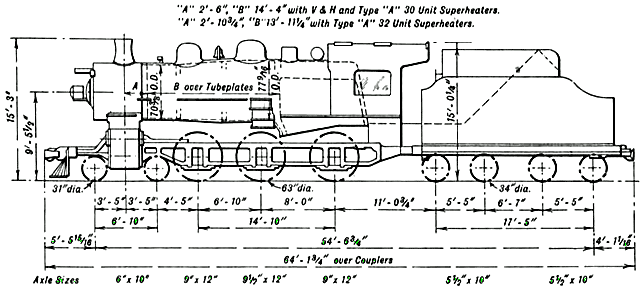
| Cylinders .................... Driving wheels ............ Tractive force ............. Boiler diameters .......... Heating surface: Tubes and flues ....... Arch tubes .............. Firebox ................... Superheater ............ Total ...................... Grate area .................. Steam pressure ........... Weight on drivers ........ Weight of engine ......... | 21 inches by 28 inches 63 inches 33,400 pounds 5 feet 10 inches and 6 feet 5 inches 14 feet 3 inches and 2 inch 29 square feet 180 square feet 408 square feet 2,846 square feet 49 square feet 200 pounds per square inch 70 tons 91 1/2 tons |
The Engineer 28 Essex Street Strand W.C. 2 London England United Kingdom.
OK, so that's the way 999 is configured in the first photo. The connecting rod between the Johnson bar and the valve linkage is located below the running board so it isn't visible. Now look at the second photo. You'll see a box on top the right side running board with some sort of apparatus protruding from the rear. This is a power reverser. There's a clearer view in the first photo of 894. In that variation, and there's a lot of variation between steam locomotives, the power reverser rests beneath the running board rather than inside a box. I'm sure engineers must have loved the guy who took pity on them by inventing this device. No more "armstrong" reversing. Basically, steam pressure or air pressure admitted to the power reverser cylinder now does the work of moving the linkage. An engineer simply operates a valve to move the cylinder and gear one direction or the other.
One more difference between the locomotives is the headlight. It either rests on top of the smokebox or is mounted on the front center. The top configuration has the number board as an integral part of the headlight. In the first photo of 999 this looks like it is an oil burning lamp. Later center mounted electric headlights had a number plate beneath the light and illuminated numbers in a separate box at the top front of the boiler. Another variation of the illuminated number board has a "V" shape, apparently to provide a better view of the number when the engine passes an observer on the ground.
So... in conclusion, examination of the photos shows multiple variations between the subclasses. I defy anyone to look at a D10 locomotive and categorically state it is of a particular subclass, or another, simply by how it looks. A valid roster, such as those in Omer Lavallee's (CPR's first official historian) book "Canadian Pacific Steam Locomotives" - 1985 - Railfare Enterprises Ltd., is "the" reference source for Canadian Pacific Railway steam locomotives.
5 Aug 2014 - Schreiber Train Group Seeks Lost Locomotive in Lake
1 Sep 2014 - Sunken Locomotives in Canada
24 Sep 2014 - Scuba Divers Search for Steam Locomotive 694
19 Nov 2014 - CP 694 in Lake Superior
CPR's Spanner Collectors' Items - Lavallee, Omer - Canadian Pacific Railway.
Power Reversing Gear - Wikipedia.
Mystery of the Missing D10 - Pearce, George - Branchline Feb 2000 Page 10.
Underwater Train Wreck Audio - Stefurak, Doug - CBC Thunder Bay "Superior Morning" 5 Aug 2014.
HO scale model D10b number 694 - Stefurak, Doug.
"Canadian Pacific Steam Locomotives" - Lavallee, Omer - 1985 Railfare Enterprises Limited.
Canadian Pacific Railway 4-6-0 Ten-Wheeler class D10b number 694 was built in February 1906 by the Montreal Locomotive Works as builders number 39374. A boiler pressure of 180 pounds per square inch worked cylinders 21 inches in diameter with a 28 inch stroke turning 63 inch drivers. Overall locomotive weight was approximately 354,000 pounds. CP 694 was wrecked 10 Jun 1910 on the Heron Bay Subdivision tumbling into Lake Superior killing the Engineer, Fireman, and Head-End Brakeman. The locomotive has never been recovered - Omer Lavallee.
Back in 2014, a small group of us started a search of the wreck of Canadian Pacific Railway (CP) number 694, a D10 steam locomotive that went off the tracks between Schreiber and Coldwell Ontario. We were able to locate some wreckage and the remains of one of the two box cars that were attached to the steam locomotive. An article describing the expedition was featured in Global Underwater Explorer's Quest Magzine (Vol 16 No. 3). Supported by Paul Turpin of Discovery Charters in Rossport Ontario and Bob Krause and the town of Schreiber, the plan was to return this summer to further explore the site with the hope of finding the locomotive itself along with the other box car and the tender. Today we met with success. Enjoy this video of CP 694 (98 Mb) taken since its tragic demise in June 1910. Reports will follow through Quest Magazine and also the Explorer's club. Many thanks to divers Ron Benson, Todd Janquart, and Dave Schlenker. Thanks to Tom Crossmon who provided the much needed ROV support. Thanks also to Paul and Beverly Turpin from Discovery Charters, Rossport, for their continued support. Safe Diving - Terry Irvine.










